Artículos SCI
2020
2020
Nanotecnología en Superficies y Plasma
Unraveling Discharge and Surface Mechanisms in Plasma-Assisted Ammonia Reactions
Navascues, P; Obrero-Perez, JM; Cotrino, J; Gonzalez-Elipe, AR; Gomez-Ramirez, AACS Sustainable Chemistry & Engineering, 8 (2020) 14855-14866
Show abstract ▽
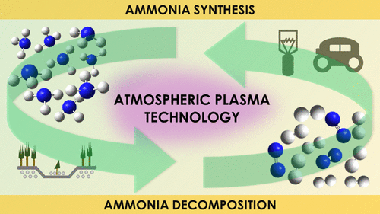
Current studies on ammonia synthesis by means of atmospheric pressure plasmas respond to the urgent need of developing less environmentally aggressive processes than the conventional Haber-Bosch catalytic reaction. Herein, we systematically study the plasma synthesis of ammonia and the much less investigated reverse reaction (decomposition of ammonia into nitrogen and hydrogen). Besides analyzing the efficiency of both processes in a packed-bed plasma reactor, we apply an isotope-exchange approach (using D-2 instead of H-2) to study the reaction mechanisms. Isotope labeling has been rarely applied to investigate atmospheric plasma reactions, and we demonstrate that this methodology may provide unique information about intermediate reactions that, consuming energy and diminishing the process efficiency, do not effectively contribute to the overall synthesis/decomposition of ammonia. In addition, the same methodology has demonstrated the active participation of the interelectrode material surface in the plasma-activated synthesis/decomposition of ammonia. These results about the involvement of surface reactions in packed-bed plasma processes, complemented with data obtained by optical emission spectroscopy analysis of the plasma phase, have evidenced the occurrence of inefficient intermediate reaction mechanisms that limit the efficiency and shown that the rate-limiting step for the ammonia synthesis and decomposition reactions are the formation of NH* species in the plasma phase and the electron impact dissociation of the molecule, respectively.
Octubre, 2020 | DOI: 10.1021/acssuschemeng.0c04461
Materiales Coloidales
Design of a nanoprobe for high field magnetic resonance imaging, dual energy X-ray computed tomography and luminescent imaging
Gonzalez-Mancebo, D; Becerro, AI; Corral, A; Garcia-Embid, S; Balcerzyk, M; Garcia-Martin, ML; de la Fuente, JM; Ocana, MJournal of Colloid and Interface Science, 573 (2020) 278-286
Show abstract ▽
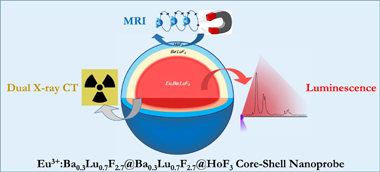
The combination of different bioimaging techniques, mainly in the field of oncology, allows circumventing the defects associated with the individual imaging modalities, thus providing a more reliable diagnosis. The development of multimodal endogenous probes that are simultaneously suitable for various imaging modalities, such as magnetic resonance imaging (MRI), X-ray computed tomography (CT) and luminescent imaging (LI) is, therefore, highly recommended. Such probes should operate in the conditions imposed by the newest imaging equipment, such as MRI operating at high magnetic fields and dual-energy CT. They should show, as well, high photoluminescence emission intensity for their use in optical imaging and present good biocompatibility. In this context, we have designed a single nanoprobe, based on a core-shell architecture, composed of a luminescent Eu3+:Ba0.3Lu0.7F2.7 core surrounded by an external HoF3 shell that confers the probe with very high magnetic transverse relaxivity at high field. An intermediate, optically inert Ba0.3Lu0.7F2.7 layer was interposed between the core and the shell to hinder Eu3+-Ho3+ cross-relaxation and avoid luminescence quenching. The presence of Ba and Lu, with different K-edges, allows for good X-ray attenuation at high and low voltages. The core-shell nanoparticles synthesized are good potential candidates as trimodal bioprobes for MRI at high field, dual-energy CT and luminescent imaging.
Agosto, 2020 | DOI: 10.1016/j.jcis.2020.03.101
Materiales de Diseño para la Energía y Medioambiente
An insight on the design of mercapto functionalized swelling brittle micas
Osuna, FJ; Pavon, E; Alba, MDJournal of Colloid and Interface Science, 561 (2020) 533-541
Show abstract ▽
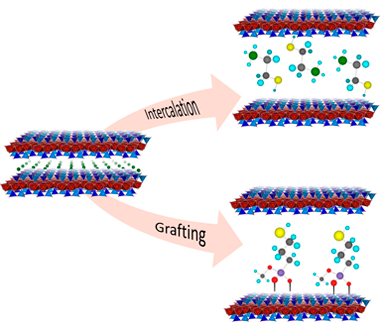
Surface modification of natural clay minerals with reagents containing metal chelating groups has great environmental value. The functionalization by adsorption or grafting guarantees a durable immobilization of the reactive organic groups, preventing their leaching when they are used in liquid media. The aim of this research was the designed mercapto functionalization of swelling brittle micas, Na-Mn, thorough both chemical and physical mechanisms. Na-Mn were functionalized with 2-mercaptoethylammonium (MEA), 2,3-dimercapto-1-propanol (BAL) and (3-mercaptopropyl)trimethoxysilane (MPTMS). The thiol concentration on swelling brittle micas is higher than the observed value for others adsorbents. The cation exchange reaction with MEA and one-step grafting with MPTMS in acid medium are the most efficient mercapto functionalization mechanism.
Marzo, 2020 | DOI: 10.1016/j.jcis.2019.11.028
Fotocatálisis Heterogénea: Aplicaciones
Influence of Sr-doping on structural, optical and photocatalytic properties of synthesized Ca3(PO4)2
Y.Naciri; A.Hsini; Z.Ajmal; A.Bouddouch; B.Bakiz; J.A.Navío; A.Albourine; J-C.Valmalette; M.Ezahri; A.BenlhachemiJournal of Colloid and Interface Science, 572 (2020) 269-280
Show abstract ▽
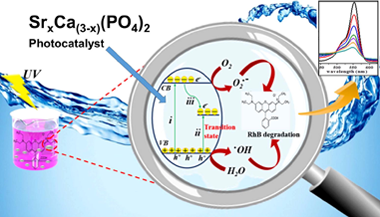
Well-crystallized Ca3(PO4)2 doped and un-doped nano-particles with the maximum strontium content (40 wt% Sr) followed by calcination at 800 °C for 3 h were synthesized via facile co-precipitation method. DTA/TGA, X-ray diffraction (XRD), energy dispersive scanning electron microscopy (SEM/EDX), UV–vis diffuse reflectance spectrum (UV–vis DRS), Raman spectroscopy and photoluminescence (PL) techniques were used for material characterization. The (XRD) patterns of as-synthesized Sr-doped Ca3(PO4)2 solid solution samples exhibited a systematic shift toward lower angles by possessing a single rhombohedral crystal structure without any secondary phases. The UV light driven photocatalytic activity was assessed for rhodamine B (RhB) degradation. As a result, ultrafast photodegradation activity was observed after Sr doping. Moreover, the 30 wt% Sr-Ca3(PO4)2 sample showed the highest photocatalytic degradation among the Sr-doped Ca3(PO4)2 samples toward RhB. It was further suggested that as-synthesized 30 wt% Sr-Ca3(PO4)2 superior photocatalytic performance is ascribed to the more proficient partition of photogenerated electron-hole pairs. Furthermore, the involved mechanism of superior photocatalytic performance of the 30 wt% Sr-Ca3(PO4)2 solid solution was also investigated. In addition, regeneration cycles indicated the higher stability of the photocatalyst to be effectively recycled up to four times without any considerable reduction in photocatalytic performance. Thus, these informations further provides us a scalable pathway to fabricate Sr doped Ca3(PO4)2 and its consequent use as an efficient photocatalyst for rhodamine B (RhB) contaminated wastewater treatment.
Julio, 2020 | DOI: 10.1016/j.jcis.2020.03.105
Química de Superficies y Catálisis
Ru-Ni/MgAl2O4 structured catalyst for CO2 methanation
Navarro, Juan C.; Centeno, Miguel A.; Laguna, Oscar H.; Odriozola, Jose A.Renewabel Energy, 161 (2020) 120-132
Show abstract ▽
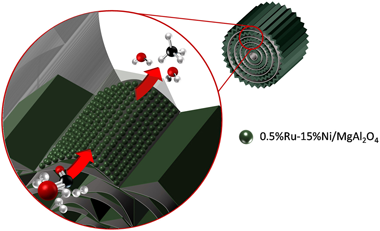
Novel catalytic systems should be tested for the valorization of CO2 through the Sabatier reaction, since this process is gaining great importance within strategic sectors of the chemical industry. Therefore, this work explores the feasibility of structuring a catalyst (0.5%Ru-15%Ni/MgAl2O4) for CO2 methanation using metal micromonoliths. The coating of the catalyst over the surface of the micromonoliths is carried out by means of the washcoating procedure and different characterization techniques are applied to establish possible changes in the catalyst during structuring.
Regarding the performance in the Sabatier reaction, the structured systems are tested as well as the powder catalyst in order to establish the possible effects of the structuring processes. For this, variables such as catalyst loading, space velocity, inclusion of water in the feed-stream and the pressurization of the process were studied.
In general, the structuring of the proposed catalyst by the reported procedure is absolutely feasible. There are no substantial changes in the main features of the catalyst and this means that its catalytic performance is not altered after the structuring process either. Furthermore, the structured system exhibits high stability in a long-term test and is comparable with other CO2 methanation catalysts reported in research to date.
Diciembre, 2020 | DOI: 10.1016/j.renene.2020.07.055
- ‹ anterior
- 92 of 410
- siguiente ›
icms











